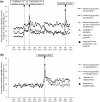Effects of medical service fee revision on reducing irrational psychotropic polypharmacy in Japan: an interrupted time-series analysis
- PMID: 34333670
- PMCID: PMC8784362
- DOI: 10.1007/s00127-021-02147-0
Effects of medical service fee revision on reducing irrational psychotropic polypharmacy in Japan: an interrupted time-series analysis
Abstract
Purpose: According to the revised Japanese medical service fees aimed at reducing irrational psychotropic polypharmacy, medical service fees are reduced if the number of simultaneously prescribed psychotropic drugs exceeds the standard. This study primarily aims to examine the effect of the 2018 revision.
Methods: Using a large Japanese administrative claims database, we retrospectively identified five groups (April 2013-September 2018) prescribed at least one drug from the following drug groups: anxiolytics, hypnotics, sum of anxiolytics and hypnotics, antipsychotics, and antidepressants (study population in each group: 547,511, 406,524, 759,137, 112,929, and 201,046, respectively). We used an interrupted time-series design to evaluate changes in the proportion of patients prescribed more than the standard number of drugs.
Results: After the 2018 revision, the proportion of patients prescribed more than the standard number of drugs significantly decreased only for the sum of anxiolytics and hypnotics; estimated changes in level and trend were - 0.60% [- 0.69%, - 0.52%] and - 0.04% [- 0.06%, - 0.02%] per month, respectively. The proportion of patients exhibiting a decrease in the number of prescribed drugs from more than the standard to within the standard increased when the revision was enforced (April 2018); this proportion in April 2018 was 36.3%, while all other proportions were in the range of 12.1-22.3%.
Conclusion: The 2018 revision promoted a reduction in the number of prescribed drugs, which served as an important factor in the decrease in the proportion of patients prescribed more than the standard number of drugs for the sum of anxiolytics and hypnotics.
Keywords: Antidepressants; Antipsychotics; Anxiolytics; Hypnotics; Polypharmacy.
© 2021. The Author(s).
Conflict of interest statement
Yusuke Okada is an employee of Pharmaceuticals and Medical Devices Agency and contributed to the present study independently of Pharmaceuticals and Medical Devices Agency.
Figures



Similar articles
-
Changes in Prescription of Psychotropic Drugs After Introduction of Polypharmacy Reduction Policy in Japan Based on a Large-Scale Claims Database.Clin Drug Investig. 2019 Nov;39(11):1077-1092. doi: 10.1007/s40261-019-00838-w. Clin Drug Investig. 2019. PMID: 31399894
-
Effectiveness of medical fee revisions for psychotropic polypharmacy in patients with mood disorders in Japan: An interrupted time-series analysis using a nationwide inpatient database.Asian J Psychiatr. 2023 Jun;84:103581. doi: 10.1016/j.ajp.2023.103581. Epub 2023 Apr 6. Asian J Psychiatr. 2023. PMID: 37086613
-
Prescribing Trends Psychotropic Drugs Against Children and Adolescents and Association with Polypharmacy Reduction Policy for Psychotropic Drugs: Based on Japanese National Database Survey.Stud Health Technol Inform. 2022 Jun 6;290:1132-1133. doi: 10.3233/SHTI220303. Stud Health Technol Inform. 2022. PMID: 35673241
-
A ten-year review of the effect of OBRA-87 on psychotropic prescribing practices in an academic nursing home.Psychiatr Serv. 1996 Sep;47(9):951-5. doi: 10.1176/ps.47.9.951. Psychiatr Serv. 1996. PMID: 8875659 Review.
-
Psychotropic dose equivalence in Japan.Psychiatry Clin Neurosci. 2015 Aug;69(8):440-7. doi: 10.1111/pcn.12275. Epub 2015 Feb 14. Psychiatry Clin Neurosci. 2015. PMID: 25601291 Review.
Cited by
-
Regional difference in multi-psychotropic drug prescription in Japan and its associated factors: an ecological study using national health insurance claims data.Res Health Serv Reg. 2023 Jan 5;2(1):1. doi: 10.1007/s43999-022-00018-y. Res Health Serv Reg. 2023. PMID: 39177732 Free PMC article.
-
Impact of the guidance on fracture Liaison Services and the introduction of a new fee for secondary fracture prevention in Japan: Implementation of secondary fracture prevention during hospitalization for fragility fractures.Osteoporos Int. 2025 Feb;36(2):235-244. doi: 10.1007/s00198-024-07269-0. Epub 2024 Dec 13. Osteoporos Int. 2025. PMID: 39671048 Free PMC article.
-
Effects of Protocol-driven Care by Internists on Adherence to Clinical Practice Guidelines for Hip Fracture Surgery Patients: An Interrupted Time Series Study Using a Nationwide Inpatient Database.Intern Med. 2025 Jul 15;64(14):2124-2135. doi: 10.2169/internalmedicine.4358-24. Epub 2025 Jan 3. Intern Med. 2025. PMID: 39756882 Free PMC article.
-
Impact of psychotropic pro re nata prescription-monitoring programme on prescriptions for inpatients with psychiatric disorders: a retrospective observational study.BMC Psychiatry. 2025 Jan 17;25(1):46. doi: 10.1186/s12888-025-06508-w. BMC Psychiatry. 2025. PMID: 39825279 Free PMC article.
-
Nationwide Long-Term Evaluation of Polypharmacy Reduction Policies Focusing on Older Adults in Japan.Int J Environ Res Public Health. 2022 Nov 9;19(22):14684. doi: 10.3390/ijerph192214684. Int J Environ Res Public Health. 2022. PMID: 36429409 Free PMC article.
References
-
- National Association of State Mental Health Program Directors (NASMHPD) Medical Directors Council and State Medicaid Directors (2001) Technical report on psychiatric polypharmacy. https://www.nasmhpd.org/sites/default/files/Polypharmacy.pdf. Accessed 12 Jan 2021
-
- Japanese Society of Mood Disorders (2019) Japanese Society of Mood Disorders guideline II: major depressive disorder 2016 (in Japanese) https://www.secretariat.ne.jp/jsmd/iinkai/katsudou/data/20190724-02.pdf. Accessed 12 Jan 2021
-
- Japanese Society of Neuropsychopharmacology (2017) Guideline for pharmacological therapy of schizophrenia (in Japanese) https://www.jsnp-org.jp/img/csrinfo/togoshiccho_00.pdf. Accessed 12 Jan 2021 - PMC - PubMed
MeSH terms
Substances
LinkOut - more resources
Full Text Sources
Miscellaneous

